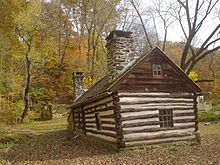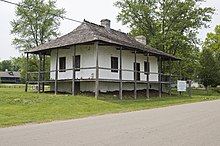American colonial architecture


American colonial architectureincludes several building design styles associated with thecolonial period of the United States,includingFirst PeriodEnglish (late-medieval),Spanish Colonial,French Colonial,Dutch Colonial,andGeorgian.[1]These styles are associated with the houses, churches and government buildings of the period from about 1600 through the 19th century.
Several relatively distinct regional styles of colonial architecture are recognized in the United States. Building styles in the 13 colonies were influenced by techniques and styles from England, as well as traditions brought by settlers from other parts of Europe. InNew England,17th-century colonial houses were built primarily from wood, following styles found in the southeastern counties of England. Saltbox style homes and Cape Cod style homes were some of the simplest of homes constructed in the New England colonies. The Saltbox homes known for their steep roof among the back the house made for easy construction among colonists.[2]The Cape Cod style homes were a common home in the early 17th of New England colonists, these homes featured a simple, rectangular shape commonly used by colonists.[3]Dutch Colonial structures, built primarily in theHudson River Valley,Long Island,and northernNew Jersey,reflected construction styles fromHollandandFlandersand used stone and brick more extensively than buildings in New England. InMaryland,Virginia,and theCarolinas,a style called "Southern Colonial" is recognized, characterized by thehall and parlorandcentral-passagehouse types, which often had largechimneysprojecting from the gable-ends of the house. In theDelaware Valley,Swedishcolonial settlers introduced thelog cabinto America. A style sometimes called Pennsylvania colonial appeared later (after 1681) and incorporatesGeorgian architecturalinfluences. APennsylvania Dutchstyle is recognized in parts of southeasternPennsylvaniathat were settled by German immigrants in the 18th century.[4]
Early buildings in some other areas of the United States reflect the architectural traditions of the colonial powers that controlled these regions. The architectural style ofLouisianais identified as French colonial, while the Spanish colonial style evokes Renaissance andBaroquestyles ofSpainand Mexico; in the United States it is found in Florida, Louisiana, New Mexico, Texas, Arizona, and California.[4]
Subtypes
[edit]First Periodis a designation given to building styles used in the earliest English settlements atJamestown, Virginia(1607), andPlymouth, Massachusetts(1620), and later in the other British colonies along the Eastern seaboard.
These buildings typically included as steep roofs, smallcasementleaded glasswindows (usually due to a scarcity of glass in the colonies), rich ornamentation (in the more expensive house only) and a massive central chimney.
French Colonial
[edit]
Developed in French-settled areas of North America beginning with the founding ofQuebecin 1608 andNew Orleans,Louisiana,in 1718, as well as along theMississippi Rivervalley toMissouri.
The early French Colonial house type of the Mississippi River Valley region was thepoteaux-en-terre,constructed of heavy upright cedar logs set vertically into the ground. These basic houses featured double-pitched hipped roofs and were surrounded by porches (galleries) to handle the hot summer climate.
By 1770, the basic French Colonial house form evolved into thebriquette-entre-poteaux(small bricks between posts) style familiar in thehistoric areas of New Orleansand other areas. These homes featured double-louvred doors, flared hip roofs, dormers, and shutters.[5]
Spanish Colonial
[edit]
Developed with the earlier Spanish settlements in the Caribbean andMexico,the Spanish Colonial style in the United States can be traced back toSt. Augustine, Florida,the oldest established city in the country, founded in 1565. The early type of dwelling inSpanish Floridawas the "board house", a small one-room cottage constructed of pit-sawn softwood boards, typically with a thatched roof.Coquina,a limestone conglomerate containing shells of small mollusks, was used as a building stone in St. Augustine as early as 1598 and has been used as recently as the 1930s in construction.[6]There were coquina quarries onAnastasia Island.From these quarries, coquina was brought to build theCastillo de San Marcos,Fort Matanzas,theCathedral Basilica,and homes throughout Florida's colonial period.[6]Tabby, made of lime, oyster shells, water, ash, and sand, was often poured out to make a hard flooring in these structures.[7]During the 18th century, the "common houses" were whitewashed in limemortarwith an oyster shell aggregate. Typically two-story, the houses included cooling porches to accommodate the Florida climate.[8]
The style developed in theSouthwestwithPueblodesign influences from the indigenousPuebloan peoplesarchitecture.
InAlta California,present-dayCalifornia,the style developed differently, being too far for imported building materials and without skilled builders, into a strong simple version for building themissionsbetween 1769 and 1823.Ranchoswere typically built ofadobe.
Dutch Colonial
[edit]
Developed from around 1630 with the arrival of Dutch colonists toNew Amsterdamand theHudson River Valleyin what is nowNew York[9]and inBergenin what is nowNew Jersey.[10][11]Initially the settlers built small, one room cottages with stone walls and steep roofs to allow a second floor loft. By 1670 or so, two-story gable-end homes were common in New Amsterdam.[12]
In the countryside of the Hudson Valley, the Dutch farmhouse evolved into a linear-plan home with straight-edged gables moved to the end walls. Around 1720, the distinctivegambrelroof was adopted from the English styles, with the addition ofoverhangson the front and rear to protect the mud mortar used in the typically stone walls and foundations.[13]
Monmouth Countyin central New Jersey has many surviving examples of a hybrid of the Dutch style termedAnglo-Dutch colonial architecture.Usually the earliest portions of the houses are one room and built in Dutch style with later additions built in theGeorgian architecturestyle. Examples being theHankinson–Moreau–Covenhoven House,theHolmes-Hendrickson House,and many houses atMonmouth Battlefield State Park.
German Colonial
[edit]
Developed after about 1675, when theDelaware River Valleyarea (Pennsylvania, New Jersey and Delaware) was settled by immigrants from Sweden, Finland, Scotland, Ireland, Germany and several other northern European nations. The early colonists to this region adapted the "half-timber" style of construction then popular in Europe, which used a frame of braced timbers filled-in with masonry. The "bank house" was a popular form of home during this period, typically constructed into a hillside for protection during the cold winters and hot summers of the region.
The two-story "country townhouse" was also common aroundPennsylvaniaduring this time.[14]
Mid-Atlantic Colonial
[edit]
The region surrounding the Chesapeake Bay on America's east coast was settled primarily by immigrants from the British isles. The standard vernacular house built by the colonists in this region between the first settlement in 1607 and the end of British rule in 1776 followed theI-plan format,had either interior or exterior gable chimneys, and was either wooden or brick. Most were only one room deep.
Academic architecture was evident, but it was relatively scarce. The best example of Mid-Atlantic Colonial academic architecture is the 1774Hammond–Harwood Housein Annapolis, Maryland. This house was modeled on the Villa Pisani in Montagnana, Italy, as exhibited in the Renaissance architect Andrea Palladio'sFour Books of Architecture(1570). Colonial architectWilliam Bucklanddesigned this house in 1774 and the resulting house is a very skillful adaptation of the Villa Pisani for the warmer climate of the Chesapeake Bay region.
Colonial Georgian
[edit]

Georgian buildings, popular during the reigns ofKing George IIandKing George IIIwere ideally built in brick, with wood trim, wooden columns and painted white. In what would become the United States, however, one found both brick buildings as well as those in wood with clapboards. They were sometimes painted a pale yellow. This differentiated them from most other structures that were usually not painted. Mostly box shaped with multiple chimneys. Georgian architecture was based on classical architecture dating to an Italian Renaissance period. ArchitectChristopher Wren,who designed theWren Buildingat theCollege of William & Mary,was a renowned Georgian architect in the colonies.[15]
A Georgian colonial house usually has a formally definedliving room,dining roomand sometimes afamily room.Thebedroomsare typically on the second floor. They also have one or two chimneys that can be very large. The Georgian architectural style was most common from the early eighteenth century until theRevolutionary War,after which the American Federal style of architecture emerged.[16]Examples of remaining Georgian buildings includeGunston Halland Hope Lodge.
Identifying features (1700 – c.1780):
- Panel front door centered, topped with rectangular windows (in door or as atransom) and capped with an elaborate crown/entablaturesupported by decorativepilasters
- Corniceembellished with decorative moldings, usually dentilwork
- Multi-pane windows and fenestrations arranged symmetrically (whether vertical or horizontal)
Other features of Georgian style houses can include – roof to ground-level:
- Roofs areSide-gabled,Gambrel,orHipped
- Chimneys on both sides of the home
- Aportico.
- Small six-panedsash windowsordormer windowsin the upper floors, primarily used for servant's quarters.
- Larger windows with nine or twelve panes on the main floors
See also
[edit]- American historic carpentry
- List of house types
- List of house styles
- Colonial Revival architecture
- Spanish Colonial Revival architecture
- Federal architecture
- Saltbox
- Cape Cod (house)
- Southern Colonial style in California
- County courthouse architecture in colonial America
References
[edit]- ^Colonial House Styles and Examples,OldHouses website (Copley Internet Systems, Inc.), accessed October 24, 2009
- ^"Saltbox Houses in the Historic American Buildings Survey - Guides, Reference Aids, and Finding Aids (Prints and Photographs ReadingRoom, Library of Congress)".loc.gov.Retrieved2017-12-05.
- ^"Cape Cod Houses Recorded by the Historic American Buildings Survey (Prints and Photographs Reading Room, Library of Congress)".loc.gov.Retrieved2017-12-05.
- ^abColonial architecture in North America,Encyclopædia BritannicaOnline, accessed October 23, 2009
- ^Lester Walker (1996),American Shelter: An Illustrated Encyclopedia of the American Home,p. 92. (1998 edition:ISBN978-0-87951-871-4andISBN0-87951-871-5)
- ^ab"The Conservation and Preservation of Coquina".CiteSeerX10.1.1.8.5698.
- ^Morris, Susan (25 July 2018)."Tabby".New Georgia Encyclopedia.Retrieved11 June2019.
- ^Lester Walker (1996),American Shelter: An Illustrated Encyclopedia of the American Home,p. 41. (1998 edition:ISBN978-0-87951-871-4andISBN0-87951-871-5)
- ^Hudson Valley Architecture: The Colonial Era (1609–1783)Archived2016-08-08 at theWayback Machine,Hudson River Valley Institutewebsite, accessed October 24, 2009
- ^Brown, T. Robins Brown; Warmflesh, Schulyler (2001),The Architecture of Bergen County, New Jersey: The Colonial Period to the Twentieth Century,vol. 2, Rutgers University Press,ISBN0813528674
- ^Bailey, Rosalie F. (1968),Pre-Revolutionary Dutch Houses and Families in Northern New Jersey and Southern New York,Dover Publications,ISBN0486219852
- ^Scheltema, Gauss; Westerhuis, Heleen (2011),Exploring Historic Dutch New York: New York City, Hudson Valley, New Jersey, and Delaware,Museum of the City of New York/Dover Publications,ISBN978-0486486376
- ^Lester Walker (1996),American Shelter: An Illustrated Encyclopedia of the American Home,p. 58. (1998 edition:ISBN978-0-87951-871-4andISBN0-87951-871-5)
- ^Lester Walker (1996),American Shelter: An Illustrated Encyclopedia of the American Home,p. 72. (1998 edition:ISBN978-0-87951-871-4andISBN0-87951-871-5)
- ^"Georgian Style 1700 - 1800 | PHMC > Pennsylvania Architectural Field Guide".phmc.state.pa.us.Retrieved2019-06-11.
- ^"Georgian Style (1700-1830)".wentworthstudio.2014-10-16.Retrieved2019-06-11.
External links
[edit]- Two Dutch Houses: Meet the Schencks -- Brooklyn Museum Online Exhibition
- Historic Home - New England Antique Real Estate
- Wells-Thorn House, Deerfield, Massachusetts
- About: Colonial HousesArchived2005-09-18 at theWayback Machine
- Examples of Colonial House style at Colonial Williamsburg, Virginia
- Examples of Colonial House style at Colonial Salem, Massachusetts
- The Restoration of a Colonial House in Virginia
- Colonial House PBS series.
- History of Colonial Architecture in Massachusetts
- Colonial Hardware - architectural hardware style during colonial era
